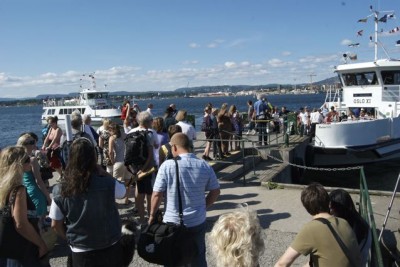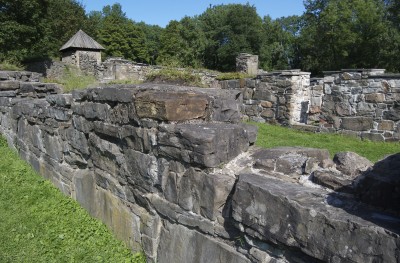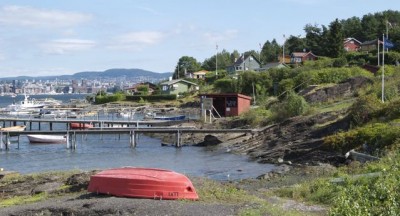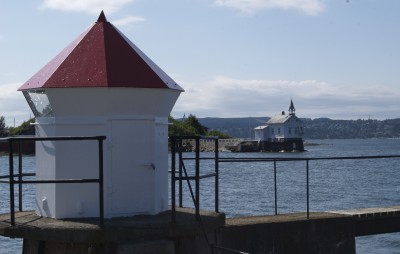EXCURSIONS: Even though Norwegian Broadcasting (NRK) recently declared that another summer is over, the weather can still be nice, at least in the inner Oslo Fjord. For those yearning to extend the summer season, it’s still fully possible to hop on a local ferry and head out to the picturesque islands that dot the fjord.

The annual proclamation that summer is over came just before 11am last Sunday, when NRK concluded this year’s airing of the daily summer broadcast called Reiseradio (literally, “travel radio”) in traditional style, by playing the classic song En sommer er over (“A summer is over”). Listening to vocalist Kirsti Sparboe croon about the birds flying south and promises that holidaymakers will meet up again next year always sets off melancholy in the hearts of many Norwegians, as they face the onset of autumn and winter.

But listeners in Oslo can defy NRK’s proclamation by simply buying a ticket on the ferries that run from Vippetangen on the city’s waterfront to the islands of Hovedøya, Lindøya, Nakholmen, Gressholmen, Bleikøya and Langøyene. The ferries are run by the city’s public transit system, now called Ruter, and are one of the best bargains in town.
A full-day ticket purchased from the machines on the pier costs NOK 45 (have exact change) and allows you to sail from island to island. Each has its own character and attractions.

The main island, aptly named Hovedøya, is the largest and features a large boat harbour, several historical buildings from its military base history and even the ruins of a cloister. While many come in the summer for seasonal art exhibits, most are keen on a day of swimming and sunshine. There’s a large beach, walking trails that are fine also in the off-season and an abundance of rare plants and wildflowers. The entire island is a nature preserve, though, and it’s not allowed to pick any of them.

The cloister ruins are surprisingly extensive and can set the imagination flying, as visitors ponder on the lives of the monks who came from England and set up the island cloister in 1147. It lasted until the mid-1500s.
The next most popular island for day-trippers is Gressholmen, which actually was the site of Oslo’s first airport. The island once had a thriving industrial community, producing linseed oil and giving rise to a residential community and a school along with its historic Heggholmen Lighthouse.
Now Gressholmen is best known for its café (Gressholmen kro) and recreational facilities. It’s also a nature preserve.
South of Gressholmen lies Langøyene, actually formed from two islands that were united through landfill that provided an outlet for Oslo’s garbage when the city was still known as Kristiania. The garbage dump was closed in 1949 and the city decided to expropriate its privately owned property and turn the now-joined islands into a park and camping ground.
The island now features beaches, a large athletic field, camping areas and walking trails. It’s been the scene of some conflicts between long-term campers who like to move out to the island and live there all summer, and the authorities, but they now seem to have reached an understanding.

Perhaps the most charming islands, though, are those dotted with small hytter (cottages) that sprung up around the beginning of the last century and have been known to sell for millions when they rarely go on the market. Ferries run all day to these islands — Bleikøya, Lindøya and Nakholmen — and it’s fun to hop off and wander around.
Lindøya is fairly large and is featured on two different ferry routes, with ferry docks on either end of the island. The ferry that comes directly from Hovedøya calls at Romerbrygga on the northwest side where there are fabulous views back across the water to Oslo and the hills. From there it’s a short walk to the swimming areas at Kjøkkenodden and around the point to Teltodden. You can also enjoy views towards Nesodden and down the broad “Bunnfjorden” end of the Oslo Fjord.
Lindøya has a small café and grocery store, an historic lighthouse and even a monument marking the Oslo Meridian. It’s a quiet and friendly place.
Nakholmen is the next stop on the route to Hovedøya and Lindøya, and it’s possibly even more charming, and affluent. This is where the chairman of Norway’s biggest bank has a cottage, and where some prominent politicians have been known to spend summer holidays. It also has a small grocery store and many small cottages, while Bleikøya also has some houses that survived from days gone by.
Many of the small residential get-aways are being shuttered for the season now, and the stores may close or curtail their hours, but the islands remain a scenic destination on a sunny autumn weekend, and can inspire dreams of next summer.
For ferry route information, click here (external link).
Views and News from Norway/Nina Berglund
Join our Forum if you’d like to comment on this story.

